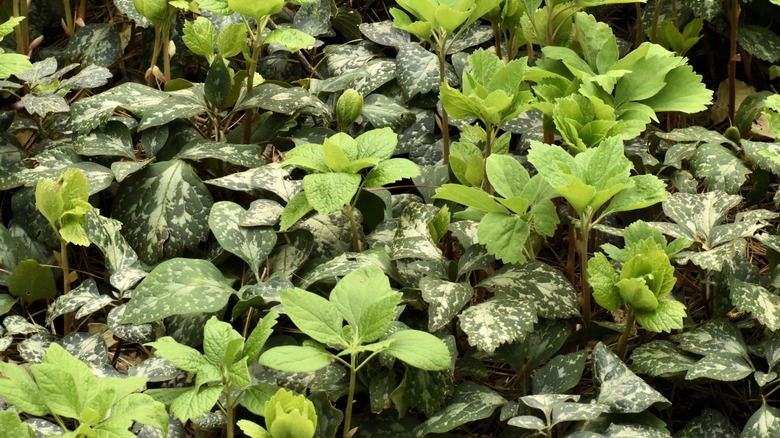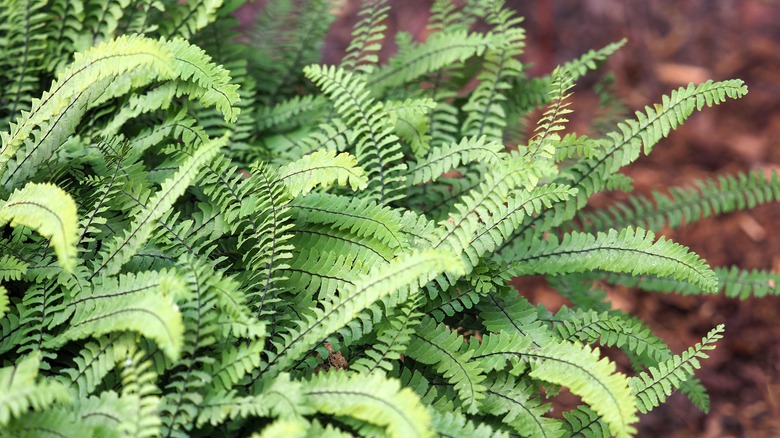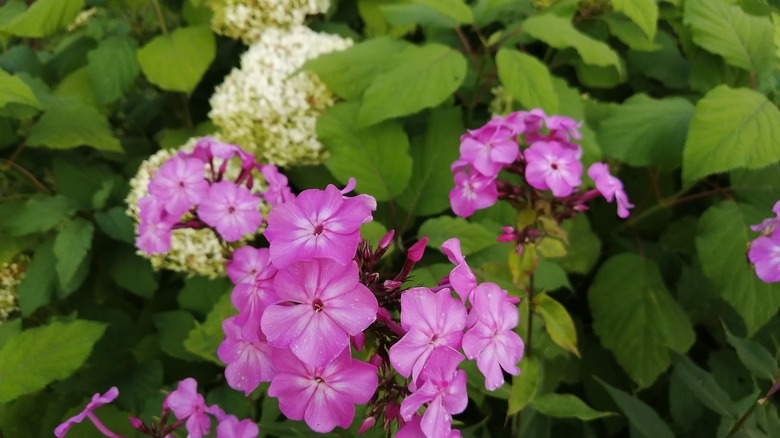Beautiful Companion Plants That Grow Well With Allegheny Spurge
With its lush, bluish-green foliage and fragrant white spring flowers, there's a lot to love about Allegheny spurge (Pachysandra procumbens). Unlike fast-spreading invasive ground covers like goutweed that can quickly take over your yard and harm other plants, this hardy native is slow-growing and easy to maintain. While this plant will surely add texture to your garden, incorporating native companion plants will take it to the next level. Aside from aesthetics, adding suitable companions can attract more pollinators, improve soil health, and make your plants more resistant to pests. To reap the benefits of companion planting, look for other species with similar care requirements. Allegheny spurge thrives in low-light conditions and grows best in fertile, well-drained soil. Hardy in zones 5-9, it loves moist soil and requires frequent watering until it's established. Once you've identified a few compatible species, you can hone in on the unique features each plant offers to get the most out of your garden.
Pair Allegheny spurge with other moisture and shade-loving natives to add texture, colors, and prolonged seasonal interest. Consider fern varieties like the northern maidenhair fern (Adiantum pedatum) for a delicate contrast to the dense Allegheny spurge foliage. If you're looking for a more colorful floral display, you can choose from ground covers, like creeping Jacob's ladder (Polemonium reptans) with delicate bluish flowers, or shrubs bursting with blooms like the oakleaf hydrangea (Hydrangea quercifolia). That said, these companions offer more than just their beauty. Let's get into all the benefits of adding these companion plants to your garden.
Add more texture with the northern maidenhair fern
The northern maidenhair fern (Adiantum pedatum) is a showy perennial with delicate, fan-shaped fronds gracefully arching from the center. Its unique foliage adds a light and airy touch, contrasting beautifully with Allegheny spurge's dense carpet of leaves. Growing up to 30 inches tall, the added height will provide a bit of vertical dimension without overshadowing the spurge's lush ground coverage. In addition to its beauty, the northern maidenhair fern is virtually free from pests and diseases, and its unpalatable leaves deter larger animals like rabbits and deer. Instead, this fern will benefit and attract valuable insects and animals to your garden. The gentle fronds offer cushioned spots for moths and butterflies to pupate, and birds use parts of the plant to build nests.
Allegheny spurge and the northern maidenhair fern have a lot in common, making them perfect companions for your garden. Each of these plants takes a less-is-more approach when it comes to light and prefers areas of your yard that don't receive as much sun. They're low-maintenance pairings, neither requiring fertilization to thrive, though you can give them a well-balanced feed once a year to replenish some nutrients. All they ask for is fertile, well-drained soil and regular watering to grow together harmoniously.
Other gorgeous plants to consider
Building a flourishing shade garden filled with varying colors of blooms may seem challenging, but with the right combinations and a little planning, you can brighten up the areas of your yard that lack sunlight. Woodland phlox (Phlox divaricata) is an award-winning spreading wildflower that has several cultivars in shades of rose, lilac, and blue. The dainty five-petaled blooms on this plant create a stunning blanket of color that thrives in low-light conditions, making it a perfect companion for Allegheny spurge — just be sure to fertilize it annually. Creeping Jacob's ladder (Polemonium reptans) is a similar-looking option with its pretty white, pink, blue, or lavender bell-shaped flowers and fern-like foliage for even more texture. Each of these flowers will attract more pollinators to your garden, including bees, butterflies, and hummingbirds, with their nectar-rich blooms.
To add even more depth and visual interest, consider adding a couple of shade-loving shrubs alongside Allegheny spurge. Oakleaf hydrangea (Hydrangea quercifolia) is a popular choice for many gardeners, with its low-maintenance qualities and fragrant, creamy-white florets. It has compatible care and pH requirements. This shrub is a host plant to the zebra swallowtail butterfly, and its showy flower clusters are like magnets to pollinating insects. Dog hobble (Leucothoe fontanesiana) is another shrub that will happily grow in acidic soil and shady areas of your garden. In spring, it produces hanging clusters of white flowers, and by fall, the leaves turn a bronzish-purple shade for year-round interest.


